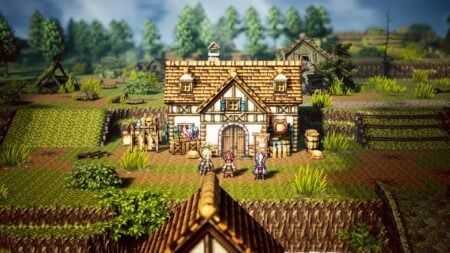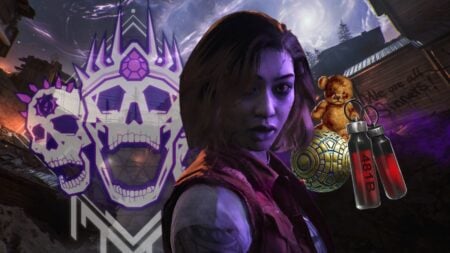With the dust beginning to settle following last month’s Summer Game Fest, one game that really stood out amongst the roster was Wētā Workshop’s cosy and relaxing life-sim Tales of the Shire. Set in the beloved universe of Tolkien’s famous novels, the much-anticipated fantasy experience is undoubtedly a perfect fit for those who love food, adventure, and friendship.
Luckily for us, The Nerd Stash was given the lovely opportunity to sit down virtually with Wētā Workshop’s Lead Game Producer, Calliope Ryder, and discuss the ins and outs of its upcoming relax ’em up. So, let’s get straight into it, shall we?
Tales of the Shire Interview With Wētā Workshop’s Lead Game Producer Calliope Ryder
Editor’s Note: The following interview has been lightly edited for clarity.
Dylan Chaundy, Editor at The Nerd Stash: I love Wētā Workshop, The Lord of the Rings, and The Hobbit trilogies and Tales of the Shire is obviously being developed by Wētā Workshop, which is the practical effects and prop company that worked on The Lord of the Rings film trilogy, The Hobbit movies, amongst many other classic films and TV shows. Expanding into the realm of video games seems like an obvious evolution. What was the main allure of expanding into video games? Has the process gone smoothly? Were there any challenges along the way?
Calliope Ryder, Wētā Workshop Lead Game Producer: Wētā Workshop has organically grown over the years from award-winning prop, costume and practical effects work on screen, to collectibles, immersive visitor experiences, and more recently game development. This expansion was a natural extension of our work in the creative industries.
We came about the game in 2020, during a time when people were stuck indoors. Many of us longed for a peaceful, simpler, more rural life. Combining cosy game player motivations at the time, and The Lord of the Rings IP Wētā Workshop is so familiar with, we came up with the concept for Tales of the Shire.
We wanted to alleviate the isolation felt during this time and create something special for The Lord of the Rings fans, and those who love cosy games, to engage with Middle-earth. We strongly felt there was a gap in this space, and with the boom of ‘cottage core’ it felt like the perfect fit for our first commercial video game.
Making a cosy game in Middle-earth does have its challenges – especially because The Lord of the Rings is usually synonymous with adventure and battle – but there have been Hobbit-sized ones too. We had long debates about how to incorporate lore when dealing with things like 10 or 12 hour clocks, or whether citrus fruit should exist – all sorts of things that are perhaps peculiar in The Shire, but required to be recognisable and useful in a video game – especially one that has such an emphasis on food. Our studio has a deep connection to the lore itself, so often we needed to take a step back and remind ourselves that we didn’t need to include absolutely everything!

Dylan Chaundy: There are so many races that make up the inhabitants within Middle-earth: Elves, Orcs, Dwarves etc. What was it about Hobbits in particular that really spoke to you and inspired you to make this game? Was it their amazing food? It was their amazing food, right?
Calliope Ryder: It was definitely their amazing food. They’re very compelling creatures! But more seriously, Hobbits live in quite a fascinating way when contrasted with the rest of Middle-earth’s inhabitants. Hobbits feel the most connected to our world as we know it – they live a rural, early 19th-century type of life, not too far off from what we could imagine. They have mantlepieces, silk handkerchiefs, clocks, a postal service (and a fairly high literacy rate), and grumble about missing their creature comforts. In contrast, the rest of Middle-earth seems legendary and medieval. Hobbits, and The Shire, feel like a bridge between our world and the grittier Middle-earth, and the rest of its inhabitants feel like they belong more in the latter.
Dylan Chaundy: Tales of the Shire takes place in Bywater, which is east of Hobbiton and Bag End in J. R. R. Tolkien’s iconic novels. How far have you gone to ensure that the game is as authentic to its source material as it can be?
Calliope Ryder: Our writer, Darren Ormandy, teaches Tolkien at Oxford University – so that’s a start! We also have incredibly knowledgeable folks here at Wētā Workshop like Dan Falconer who worked on all the films, and of course Richard Taylor [Founder of Wētā Workshop]. These people have been working with Tolkien’s material for many many years, so there’s not a lot they don’t know. We’ve also been able to incorporate a lot of lore that players might not expect without breaking lore rules. While we never leave Bywater in Tales of the Shire, the land itself had many inhabitants prior to Hobbits, and we’ve included glimpses of Middle-earth’s history through our narrative and the environment building. The game is peppered with little nods to lore throughout, so eagle-eyed Tolkien aficionados will be rewarded with references that others might not notice. The more you know, the more you’ll appreciate! We’re really looking forward to the reaction from fans, the game really is like a ‘love letter’ to Tolkien’s work.
Dylan Chaundy: From the trailer we’ve seen, Tales of the Shire will be filled to the brim with interesting and compelling activities like fishing, cooking, decorating, and foraging. What other activities can players look forward to partaking in?
Calliope Ryder: We really lent on the “small” version of everything, focusing heavily on encapsulating the best parts of both rural life and of being a Hobbit. Hobbits aren’t very interested in the outside world and adventures, so instead their priorities are about their bursting pantries, growing large crops, and good parties. Instead of min-maxing to get the most cash, trading with your neighbours is important. Instead of ‘farming’, we have gardening. Community with your fellow Hobbits is essential, and sharing home-cooked meals is the best way to a Hobbit’s heart. Developing friendships and bringing the community of Bywater together is also going to play a big part of the game.

Dylan Chaundy: Tales of the Shire is being billed as a cosy life-sim. So far, there hasn’t been much of an emphasis on combat leading up to launch. Is that a deliberate decision? I mean, Tolkien’s universe is filled with danger at every turn — will there be any element of danger? Will the game feature any combat?
Calliope Ryder: Tales of the Shire is set in a peaceful era of Middle-earth history between the events of The Hobbit and The Lord of the Rings, and happily centered about the Hobbit lifestyle which celebrates food, friendship and fellowship. You’ll likely come across some disagreements between a couple of the Bywater inhabitants, but that’s about as close to combat as you’re going to get in this game.
Dylan Chaundy: From what we can gather, Tales of the Shire appears to be a wholly single-player experience. Were any multiplayer concepts ever discussed internally? Is there a chance of any sort of co-op gameplay in the future?
Calliope Ryder: Yes, Tales of the Shire is a single-player game. We wanted people to play at their own pace, creating a leisurely experience that is dictated by the player alone. Currently there are no plans for multiplayer, but we’re very excited to see players create communities and share their decorations and customisations with others!
Dylan Chaundy: J. R. R. Tolkien’s Middle-earth is so rich and jam-packed with deep lore. How was it translating some of the lesser-known locales and characters from Tolkien’s vast mythos into a video game format?
Calliope Ryder: We’ve got a fantastic setting to work with for this game – there’s bookends of well-known activity on either side (The Hobbit and The Lord of the Rings), and we’re lucky enough to be in a place where events aren’t very notable when compared with the epic stories of the rest of Middle-earth. One concern we’ve been careful with is how much we use or refer to well-known characters. We want players to feel like they recognise the places, last names, and a couple of side characters – but we don’t want to create prequel stories for those characters that have a large role to play in Tolkien’s works on either side. It’s been a balancing act.

Dylan Chaundy: Tales of the Shire’s art-style features a beautiful, painterly aesthetic that’s reminiscent of John Howe and Jon Hodgson’s work in The One Ring board game. When it comes to the visual presentation, what were your main influences? Were there any inspirations that were not related to Tolkien or The Lord of the Rings?
Calliope Ryder: We are lucky to live in Aotearoa New Zealand, so a lot of influence came from our own natural landscape. Patterns and motifs were inspired by both Tolkien’s own art and influences from the Arts and Crafts movement, which felt particularly ‘Hobbity’. We really wanted to create a childlike, idyllic version of Middle-earth – just like how the tone of The Hobbit feels like a fairy tale when compared to the tone of The Lord of the Rings books.
Dylan Chaundy: If you had full creative control over what your team works on next, what would it be? What would your dream project look like? Would it be set in Middle-earth?
Calliope Ryder: It’s really hard to pick a dream project, we’ve got such a breadth of talent here at Wētā Workshop that it really could be anything. For now, we’re focused on launching Tales of the Shire, and after that let’s see where our journey takes us.
Dylan Chaundy: When can we expect to see Tales of the Shire, and for what platforms?
Calliope Ryder: Tales of the Shire is launching this winter (2024), for Nintendo Switch, PC, PlayStation 5,
We’d just like to thank Calliope Ryder and all the kind folks at Wētā Workshop for taking the time out of their busy schedules to chat in-depth about Tales of the Shire. We’re looking forward to getting even more hands-on time with the much-anticipated life-sim when it launches later this year.







